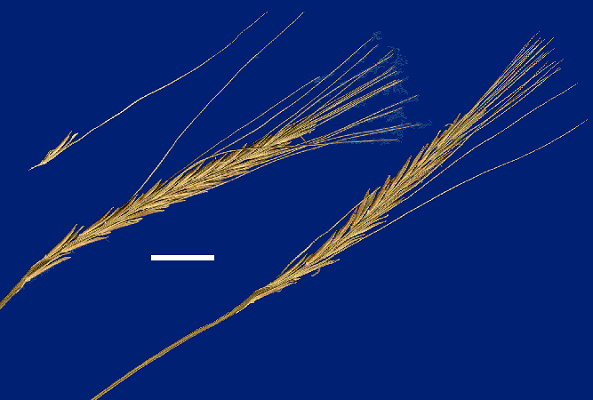 |
 |
|
 |
 |
|

Chamaeraphis hordeacea R.Br. |
Derivation
Chamaeraphis R.Br., Prodr. 193 (1810). From the Greek chamai
(low growing) and raphis (needle). Creeping or low growing plants with
inflorescences whose central axes terminate in a stout bristle.
hordeacea- from the Latin -acea (resembling). Inflorescence as with Hordeum.
Published in
Prodr. 193 (1810).
Habit
Perennial, tufted. Culms 25–60 cm tall. Leaves distichous. Ligule a fringed
membrane, 0.8–1.2 mm long. Leaf-blade base broadly rounded. Leaf-blades
3–10 cm long, 2–5 mm wide. Leaf-blade surface scabrous. Leaf-blade
apex obtuse or acute.
Inflorescence
Inflorescence solid, a raceme. Racemes numerous, closely spaced, in a bilateral
false spike, 20–60 cm long, bearing 1 spikelet. Central inflorescence axis
3–5.5 cm long, flattened. Rhachis deciduous from axis, terminating in a
barren bristle-like extension. Spikelet packing abaxial. Raceme-bases linear,
1.5–3 mm long, pubescent, shed with the raceme, pungent.
Spikelets
Spikelets solitary. Fertile spikelets 2-flowered, comprising 1 fertile floret,
without rhachilla extension, linear, dorsally compressed, 6–8.2 mm long,
falling entire, deciduous with accessory branch structures.
Glumes
Glume 1, the lower absent or obscure. Upper glume linear, 6–8.2 mm long,
150% of length of adjacent fertile lemma, coriaceous, 2-keeled, 7-nerved,
midnerve scaberulous. Upper glume surface glabrous. Upper glume apex obtuse.
Florets
Basal sterile floret 1, with palea. Lemma of lower sterile floret linear or
oblong, 6–8 mm long, 100% of length of spikelet, coriaceous, 7–9(–11)-nerved,
scaberulous, rough on nerves (above), glabrous, acute. Fertile lemma lanceolate,
3.3–6 mm long, cartilaginous, 3-nerved. Lemma surface glabrous. Lemma margins
convolute, covering most of palea. Lemma apex acute. Palea cartilaginous, without
keels.
Continental Distribution:
Australasia.
Australian Distribution:
Northern Territory, Queensland.
Northern Territory: Darwin & Gulf, Barkly Tableland. Queensland: Burke.
Classification. (GPWG
2001):
Panicoideae: Paniceae
Notes
Endemic. In tropical and subtropical sub-humid woodlands and coastal grasslands.
Flowers Feb.–July.

Inflorescence (scanned specimen)
© Queensland Herbarium
by D. Sharp